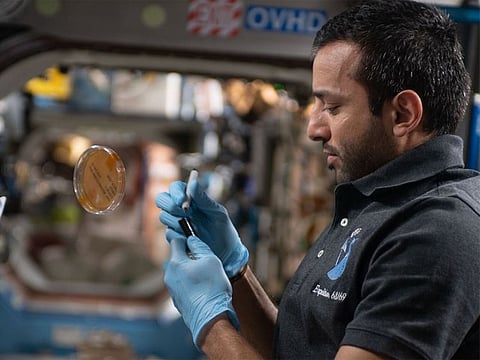Look: UAE astronaut Sultan Al Neyadi fights microbial hitchhikers in space
Sultan of Space monitors ISS cabin to detect contamination by airborne bacteria, fungi

Dubai: UAE astronaut Sultan Al Neyadi, who is on the longest Arab space mission aboard the International Space Station (ISS), on Tuesday revealed an important task that he does on the ISS—fighting microbial hitchhikers in space.
In a social media post, Al Neyadi, who serves as Expedition 69 flight engineer, explained that millions of microbes reach the ISS every year.
“This is why it’s important for us to monitor the ISS cabin for airborne bacteria and fungi in order to protect our health and study their behavior,” he stated.
Al Neyadi also shared two images with the post and described them stating: “Here I am watching this Petri dish to detect any contamination.”
How do microbes reach space?
Microbiologists have found that microbes can live just about everywhere, on us human beings and even in space. Microbial hitchhikers have the capability to catch a ride to space, with either the cargo or the crew. Therefore, cleanliness and proper disposal of garbage is an important part of living on the ISS and culture-based microbial monitoring is done continuously.
Petri dishes are shallow cylindrical containers with fitted lids that are designed specifically for microbiology or cell culture use. They hold different types of growth medium in which cells can be cultured, originally, cells of bacteria, fungi, and small mosses. The container is named after its inventor, German bacteriologist Julius Richard Petri.
Procedures to benefit space, Earth
Scientists use the International Space Station as a testing ground to study how to keep astronauts safe and healthy on long-duration missions. The ability to identify microbes in space could aid in the diagnosis and treatment of astronaut ailments in real-time. These studies also benefit humans on Earth by providing a better understanding of how microbes behave in a sanitised, isolated, and confined environment.
From simple procedures that can be performed by crew members who may not be microbiologists to DNA sequencing of microbes by astronauts who are microbiologists, NASA has designed several methods to conduct research on microbes on the ISS. Earlier, a series of NASA microbial tracking experiments and the 3D Microbial Monitoring study had to rely on astronauts collecting hundreds of samples by wiping down selected surfaces with swabs, packing the samples in plastic bags, and sending them back to Earth for identification with DNA sequencing facilities.
The NASA research team has gone on to collaborate with the Centers for Disease Control, looking into how streamlined procedures developed for the space station can be implemented to determine the cleanliness of hospital rooms. Using these microbial tracking methods in hospitals could provide a much faster turnaround time, even when implemented by untrained individuals. This capability might give hospitals the tools to detect microbes that may be resistant to antibiotics that could be present even after cleaning.
Did you know?
One of the earliest instances that surprised NASA scientists about microbes in space took place way back in the 1960s.
On April 20, 1967, the unmanned lunar lander Surveyor 3 landed near Oceanus Procellarum on the surface of the Moon. One of the onboard items included a television camera. Two-and-a-half years later, on November 20, 1969, Apollo 12 astronauts Pete Conrad and Alan L. Bean recovered the camera.
When NASA scientists examined it back on Earth, they were surprised to find some bacteria called Streptococcus mitis were still alive. Because of the precautions the astronauts had taken, NASA was sure that the germs found inside the camera had been in the camera since before Surveyor 3 launched into space. These bacteria had survived for 31 months in the vacuum of the Moon’s atmosphere. They may have frozen or dried inside the camera, which are two ways normal bacteria can enter a state of deep sleep.
Sign up for the Daily Briefing
Get the latest news and updates straight to your inbox
